AMABHUNGANE
UPL Cornubia catastrophe: Highly toxic cocktail of chemicals in smoke plume finally identified
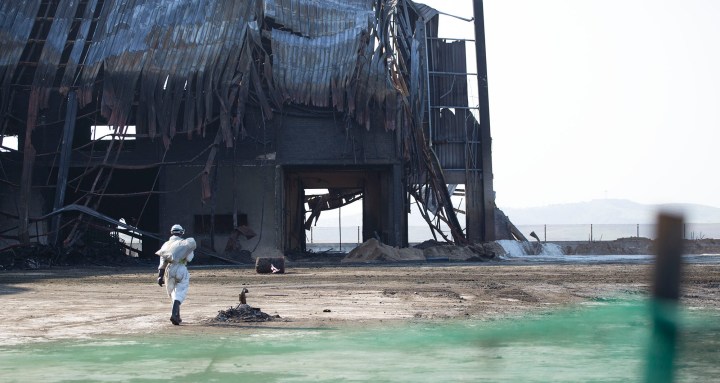
Seven months after a chemical warehouse in Durban was set alight, residents finally have some answers about what chemicals they inhaled.
For months, residents of Durban have been pleading to know which toxic chemicals they were exposed to when the UPL chemical warehouse was set alight during the July 2021 unrest.
Now, finally, they have some answers.
The UPL warehouse in Cornubia was storing thousands of tons of pesticides. At about midnight on 13 July, the building was torched as part of the ongoing violence in KwaZulu-Natal.
In the days that followed, a toxic soup of chemicals flowed into the Ohlanga River, turning the Umhlanga Lagoon a luminous turquoise and killing thousands of fish. The fire also blanketed northern Durban in acrid smoke for more than a week, leaving residents struggling to breathe and with few answers about what was in the air.
Last week, the provincial government finally released an atmospheric impact report, commissioned as part of the mammoth clean-up of the chemical disaster.
The report, produced by Airshed Planning Professionals in Midrand, identifies 62 chemicals that were likely present in the smoke, the “most significant” being hydrogen cyanide, hydrochloric acid and bromine, as well as pollutants more commonly associated with coal power plants: SO2, NO2 and PM.
The report concludes that most suburbs in the area were exposed to levels of chemicals that caused temporary symptoms — coughing, running nose, tearing eyes — but a significant number experienced levels capable of causing “irreversible or other serious, long-lasting adverse health effects”.

The UPL warehouse north of Durban, torched during the July unrest, triggered an environmental disaster. (Photo: Mlungisi Mbele)
The three worst affected areas were the surrounding suburbs that make up Blackburn Estate; Blackburn Village, an informal settlement that is home to 7,000 people; and the area surrounding Reddam Umhlanga School.
The UPL chemical disaster should be treated as a “regional” incident, Airshed concludes, and its “impact significance” should be rated as “very high”.
When asked if UPL disputed the results or conclusions of the Airshed report, spokesperson Japhet Ncube said: “No, bearing in mind that it is based on a number of assumptions, including conservative assumptions based on a cautious approach, which assumptions may or may not be 100% accurate. UPL is, however, satisfied that the report is done on a solid and scientific basis, using internationally accepted air monitoring modelling. And, we consider it to be a well-researched and very helpful assessment.”
He added that it was “a conservatively modelled study” of the “worst-case scenario”.
The chemical culprits
There were two distinct phases of the fire, according to the Airshed report: the phase when the 14,000m² warehouse was actively burning, which lasted for roughly 48 hours, and the phase when the fire was extinguished but the smouldering debris continued releasing chemicals into the air, which continued for another week.
“Initially the smoke and toxic products would have been relatively low but, as the fire develops, the generation of carbon monoxide (CO) and carbon dioxide (CO2) could have been significant,” the report found.
“When the air supply became more constricted … high concentrations of [carbon monoxide], hydrochloric acid, organic products, smoke and other inorganic acid gases would have occurred.”
In the chaos created by the July unrest, there was a delay in firefighters reaching the site. After they began to extinguish the fire, the debris started smouldering and releasing chemicals, some that were “odourless and highly irritant to the respiratory tract” and others that produced a strong, sulphur-like smell.
“During the smouldering phase, the most significant pollutants identified include [ammonia] and naphthalene,” the report found.
It was only at this point that most residents became aware that something was amiss.
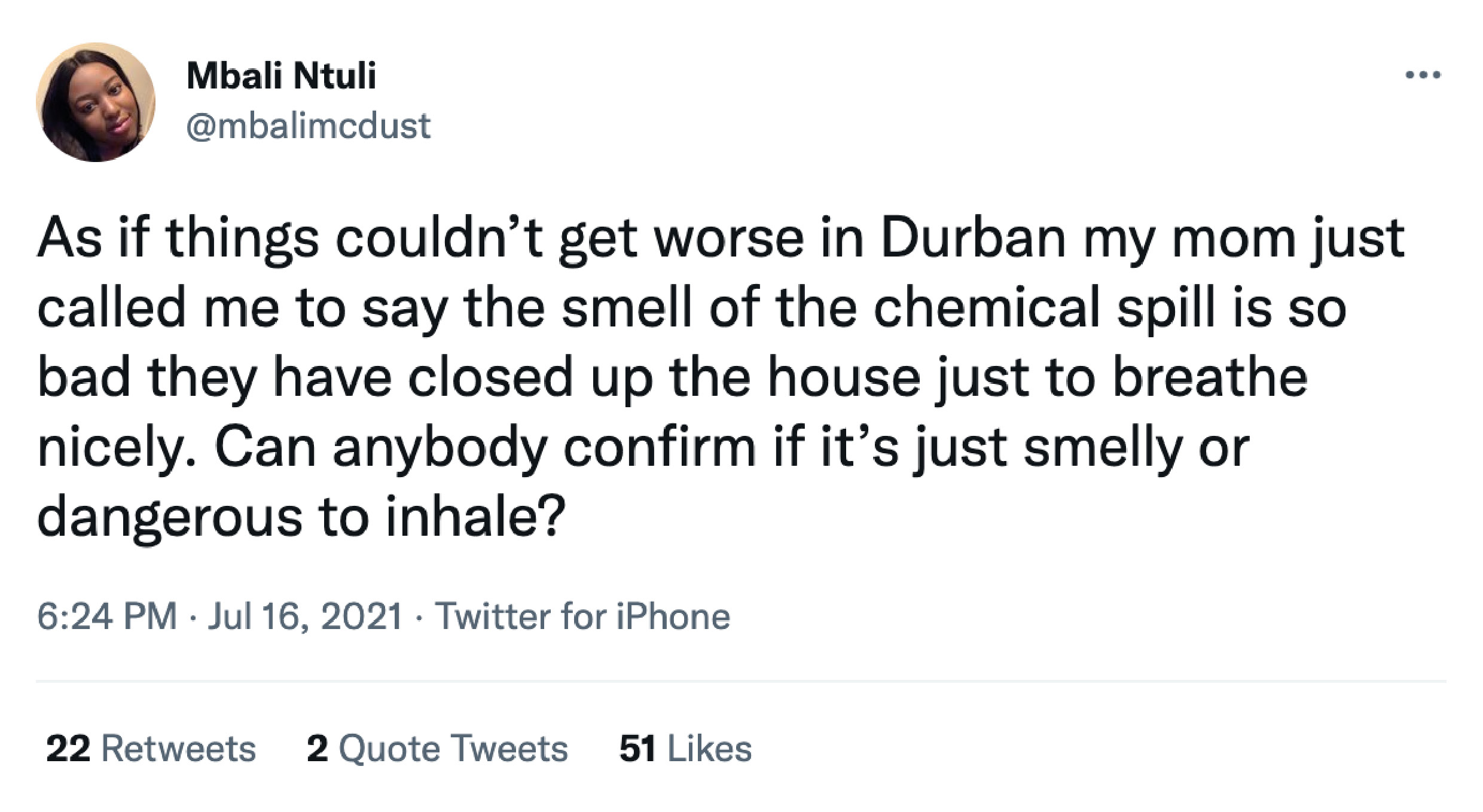
amaBhungane began investigating the UPL fire after DA politician and Durban resident Mbali Ntuli asked Twitter for answers about the choking fumes.
“The fire started in the evening, the following day we started to smell that smoke [and realised] it’s not normal … If you have ever been there when tyres are burning, it smells like that,” Kwanele Msizazwe, a community leader from Blackburn Village told amaBhungane.
A few kilometres away, local ward councillor Nicole Bollman had the same experience: “Initially it smelled like Guy Fawkes, like sulphur,” she said. “That’s what it sort of smelled like at the beginning and then it became sickening, like nausea. It sort of hit the back of your palate and sinuses. As soon as the smoke started hitting, that’s when the question started getting asked … what was in there?”
Exposure
One of the reasons it has taken so long to answer this question is that samples from the chemical plume were only taken on 17 July 2021, four days after the fire began. These samples provided some data, but to get a full picture Airshed had to calculate which gases UPL’s inventory of roughly 700 pesticides would release as they burned.
Meteorological data from nearby weather stations showed that the wind initially blew the smoke from the fire south but it quickly changed direction, putting Blackburn Estate and Blackburn Village in the direct path of the chemical plume.
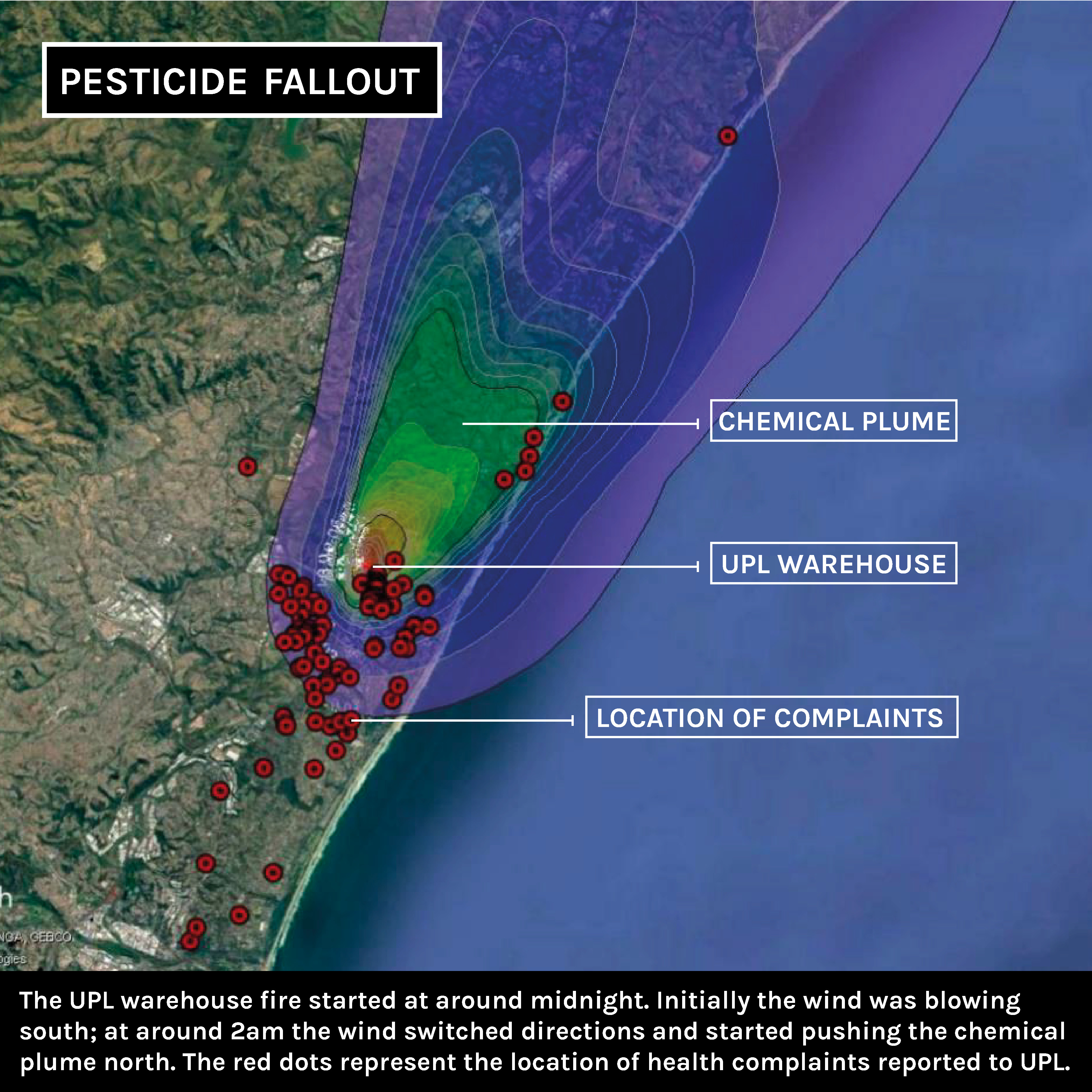
The Airshed report uses Acute Exposure Guideline Levels (AEGLs), a system used by the US’s Environmental Protection Agency, to “describe the human health effects from once-in-a-lifetime, or rare, exposure to airborne chemicals”.
There are three levels: at AEGL level 1, one “could experience notable discomfort, irritation or certain asymptomatic non-sensory effects”. However, these effects are likely to be short-lived and should disappear when you are no longer exposed to the chemical in question.
At AEGL 2, however, a once-off exposure could lead to “irreversible or other serious, long-lasting adverse health effects”.
At AEGL 3, chemicals are present at such extreme levels as to cause “life-threatening health effects or death”.
The model Airshed produced estimates that virtually the entire north Durban area could have been exposed to AEGL 1 levels of sulphur dioxide, nitrogen dioxide, hydrochloric acid and bromine.
Hydrochloric acid produces a “pungent, suffocating odour”. When low levels (1.8ppm for 45 minutes) were tested on human volunteers, their symptoms included “sore throat and nasal discharge”, “cough, chest pain or burning, [shortness of breath], wheezing”, and “fatigue, headache, dizziness, unusual taste or smell”.
The concentrations produced by the UPL fire varied from a maximum of 2.71ppm at the Little Einsteins Preprimary School to 30.60ppm at Blackburn Estate, both over an hour-long period.
Airshed concluded that the levels of hydrochloric acid in Blackburn Estate were likely high enough over a four-hour period to be classified as AEGL 2, i.e. capable of causing irreversible health impacts.
Ncube said UPL accepted that smoke from the fire had caused short-term health effects, but added that, in the company’s view, “such health effects were certainly reversible”.
UPL seems less willing to accept that the incident might have caused long-term damage: “The report’s conclusions are not disputed, but must be fully contextualised. The Airshed report, on its own admitted terms, is based on modelling that uses a number of critical assumptions. As pointed out by the author, whether those assumptions are correct or not will only be verified once the human health risk assessment has been conducted,” Ncube said.
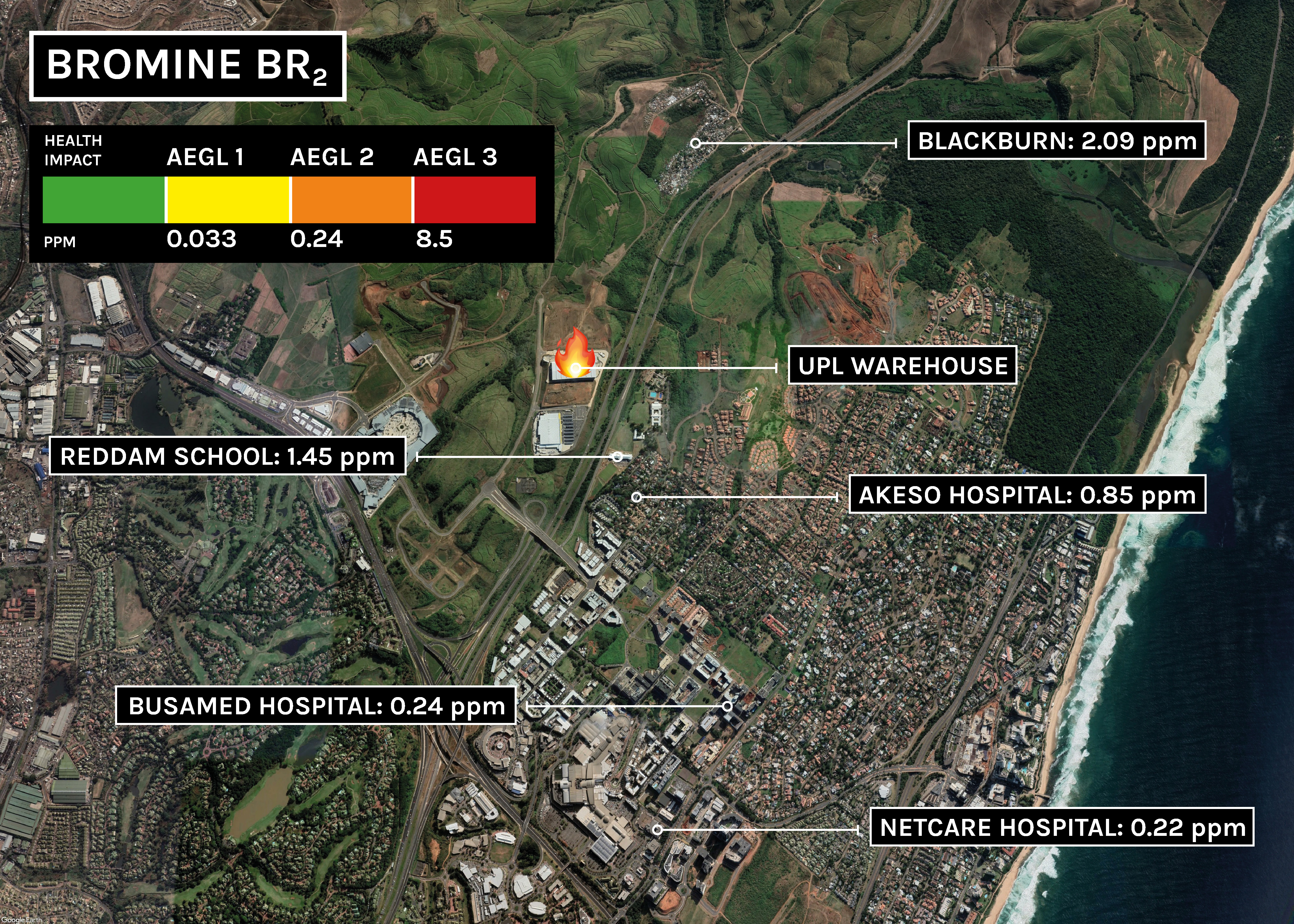
Bromine is a “skin, eye and respiratory tract irritant”. Although studies on humans are rare and decades old, the AEGL guidelines note: “The signs and symptoms associated with human exposure to low concentrations [of bromine] include upper airways irritation, inflammation of the eyelids, [tearing], coughing, nosebleed, and a feeling of oppression, dizziness, and headache.”
At 0.03ppm (AEGL 1) one is likely to experience eye irritation, at 0.5ppm (AEGL 2), the effect on eyes, nose and throat becomes disabling. The concentrations produced by the UPL fire varied from a maximum of 0.03ppm at Mahatma Gandhi Memorial Hospital to 2.09ppm at Blackburn Estate (over an hour-long period).
The AEGL guidelines also note: “After several hours these symptoms may be followed by abdominal pain and diarrhoea and a measles-like eruption on the trunk and extremities.”
Airshed believes that a far longer list of areas was exposed to AEGL 2 levels of bromine, from the Netcare Umhlanga Hospital (0.22ppm over an hour) to Blackburn Estate (2.09ppm over an hour).
The full list of areas exposed to AEGL 2 levels of bromine is available in tables 5-24 and 5-25 in the Airshed report, which you can download from our Evidence Docket below.
Sulphur dioxide, the common pollutant from coal-fired power plants, was also likely present at AEGL 2 levels in many areas. The National Ambient Air Quality Standards limits sulphur dioxide to 0.134ppm; just below the AEGL 1 level of 0.2ppm.
Airshed estimates that sulphur dioxide exceeded AEGL 2 levels (0.75ppm over an hour) at 26 sites, including Busamed Gateway Private Hospital (3.12ppm), Umhlanga Medical Institute (3.8ppm) and the Akeso psychiatric hospital in Umhlanga (10.88ppm).
Luckily, Airshed concluded that exposure to hydrogen cyanide had been much more limited, with only three areas exposed to levels AEGL 1 levels (1ppm over an hour).
Hydrogen cyanide was used as a chemical weapon during the First World War and at high concentrations of 100 to 200ppm will kill a person in an hour. The concentrations produced by the UPL fire, however, were between 2.58 at Reddam and 3.73ppm at Blackburn Estate, which is likely to produce nothing more than a mild headache.
Chemical fallout
One of Airshed’s biggest challenges was that no one is quite sure which pesticides burned in the fire and which washed down into the Ohlanga River.
“It is difficult to determine the exact amount of the warehouse contents that washed away in the firewater, but, for the purposes of the air pollution impact assessment, it was assumed that most of the highly flammable materials (eg solvents) would have been consumed in the fire, ranging between 85% to 95%, assuming an average of 90%,” the report notes.
Earlier reports found high levels of arsenic, atrazine and bromoxynil in places that were exposed to the contaminated firefighting water. Read amaBhungane’s report: UPL disaster: Initial tests found high levels of arsenic from Durban’s chemical spill.
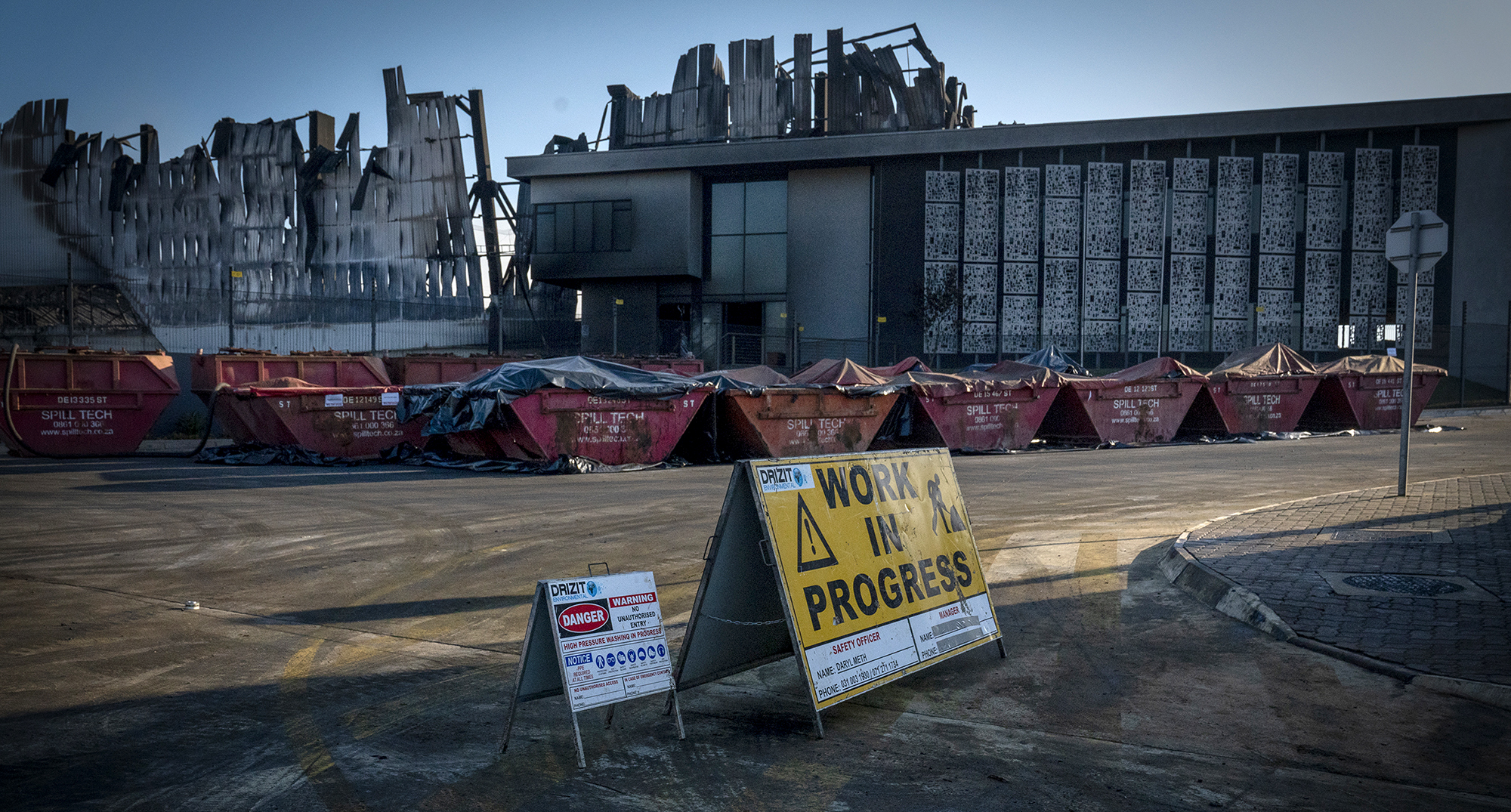
Waste skips containing hazardous debris lined up next to the charred remains of the UPL chemical warehouse in the aftermath of looting and unrest in KwaZulu-Natal. (Photo: Shiraaz Mohamed)
The report, however, assumes that some of the pesticides survived and were carried up with the smoke and deposited, unburnt, in other surrounding areas. The extent of this additional source of potential contamination is clear from an interim situation report provided by Apex Environmental, the company leading the clean-up.
This second report reveals that at least 40 swabs have been taken at Reddam Umhlanga, located across the road from the destroyed UPL warehouse. Tests on the swabs were looking for “pesticides” and “hazardous chemical agents” on everything from the playground slide to toys in the early learning centre to the swimming pools.
The report shows that samples were also taken from swimming pools all along Chestnut Crescent and from vegetable gardens in Blackburn Village.
The Apex report discloses that at least 217 people have been under medical surveillance because of their exposure to the fire and chemically contaminated debris. This includes 32 firefighters, 15 security guards and 166 members of the clean-up crews who are still on site.
The report also contains a summary of the symptoms reported in the 117 complaints from residents that UPL had received by November. These include everything from “headaches, blacking out, [and] dizziness” to “difficulty breathing, rapid breathing, [and] burning chest”.
Many of these effects are likely to be temporary. But Apex says it will take time and a multi-disciplinary approach to quantify the human fallout from the UPL disaster.
“Chemical exposure as a result of aerosolised chemicals, fumes and smoke plumes may potentially induce both acute and chronic adverse health effects, many of which have long latency periods,” it warns, meaning that, for some residents, it could take months or years for symptoms to develop. DM
The amaBhungane Centre for Investigative Journalism is an independent non-profit organisation. We co-publish our investigations, which are free to access, to news sites like Daily Maverick. For more, visit us on www.amaB.org.
This story was updated to remove a reference to 19,000 tons of pesticides being stored in the UPL warehouse. The Airshed report estimates that there were more than 4,000 tons of pesticides in the warehouse at the time of the fire.
[hearken id=”daily-maverick/9153″]





















 Become an Insider
Become an Insider
Awful
All UPL Board members and senior managers, together with government officials who signed off on the storage area should be jailed, not fined jailed, for negligence.
At last, some useful (if horrifying) information on this disaster. But not enough – the beach at Umhlanga lagoon is still closed to the public, and nowhere can I find information on what toxic substances are causing this, whether monitoring of the toxin levels is ongoing and what is being found.
Surely the public should be kept informed?
How, exactly, was the warehouse state-of-the-art?
The press release by UPL on 17 July 2021 states the warehouse stored ‘plant protection products’ and that ‘The repeated attacks, as well as the unrest which prevented a rapid response, resulted in the brand new facility’s security and state-of-the-art safety features being overwhelmed.’
https://www.upl-ltd.com/za/news-details/press-release-for-immediate-release
Hydrogen Cyanide – was this not the gas used by the Nazis – Zyklon B? With such an extremely toxic gas in the air were there no fatalities??
Thanks for the report. So now the door is opening we can assess the options for a Class action case against UPL, the local govt for failures etc and ensure that any payoffs are monitored to exclude the ANC from using them to fund 2024 electioneering.
And orange overalls for the directors et al as Gerrie says
Any class action should be against those that started the fire and their instigators…….